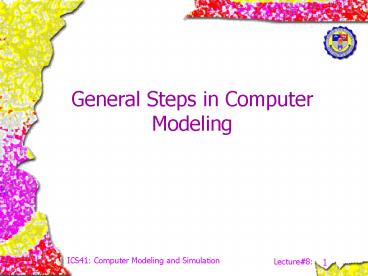General Steps in Computer Modeling - PowerPoint PPT Presentation
1 / 15
Title:
General Steps in Computer Modeling
Description:
program the model in a programming language or in simulation software ... ICS41: Computer Modeling and Simulation. Lecture#8: Design experiments ... – PowerPoint PPT presentation
Number of Views:503
Avg rating:3.0/5.0
Title: General Steps in Computer Modeling
1
General Steps in Computer Modeling
2
(No Transcript)
3
Formulate the problem and plan the study
- problem of interest is stated by manager
- one or more kickoff meetings for the study are
conducted, with the project manager, the
simulation analysts, and subject-matter experts
in attendance. - issues discussed
- overall objectives of the study
- specific questions to be answered by the study
- performance measures that will be used to
evaluate the efficacy of different system
configurations
4
Formulate the problem and plan the study
- issues discussed (cont)
- scope of the model
- system configurations to be modeled
- software to be used
- time frame for the study and the required
resources
5
Collect data and define a model
- collect information on the system layout and
operating procedures - no single person or document is sufficient
- some people may have inaccurate information
make sure that true SMEs are identified - operating procedures may not be formalized
- collect data (if possible) to specify model
parameters and input probability distributions
6
Collect data and define a model
- delineate the above information and data in an
assumptions document, which is the conceptual
model - collect data on the performance of the existing
system (for validation purposes) - there need not be a one-to-one correspondence
between each element of the model and the
corresponding element of the system - interact with the manager on a regular basis
7
Collect data and define a model
- the level of model detail should depend on the
following - project objectives
- performance measures
- data availability
- credibility concerns
- computer constraints
- opinions of SMEs
- time and money constraints
8
Is the conceptual model valid?
- perform a structured walk-through of the
conceptual model using the assumptions document
before an audience of managers, analysts, and
SMEs - help ensure that the models assumptions are
correct and complete - promotes ownership of the model
- takes place before programming begins to avoid
significant reprogramming later
9
Construct a computer program and verify
- program the model in a programming language or
in simulation software - verify (debug) the simulation computer program
10
Is the programmed model valid?
- if there is an existing system, then compare
model and system performance measures for the
existing system - regardless of whether there is an existing
system, the simulation analysts and SMEs should
review the model results for correctness - use sensitivity analyses to determine what model
factors have a significant impact on performance
measures and, thus, have to be modeled correctly
11
Design experiments
- specify the following for each system
configuration of interest - length of each run
- length of the warmup period, if one is
appropriate - number of independent simulation runs using
different random numbers
12
Make production runs
- production runs are made to be used in the next
step
13
Analyze output data
- two major objectives in analyzing output data
are - determining the absolute performance of certain
system configurations - comparing alternative system configurations in a
relative sense
14
Document, present, and use results
- document assumptions, computer program, and
studys results for use in the current and future
projects - present studys result
- use animation to communicate model to managers
and other people who are not familiar with all of
the model details - discuss model building and validation process to
promote credibility
15
Document, present, and use results
- results are used in decision-making process if
they are both valid and credible.































